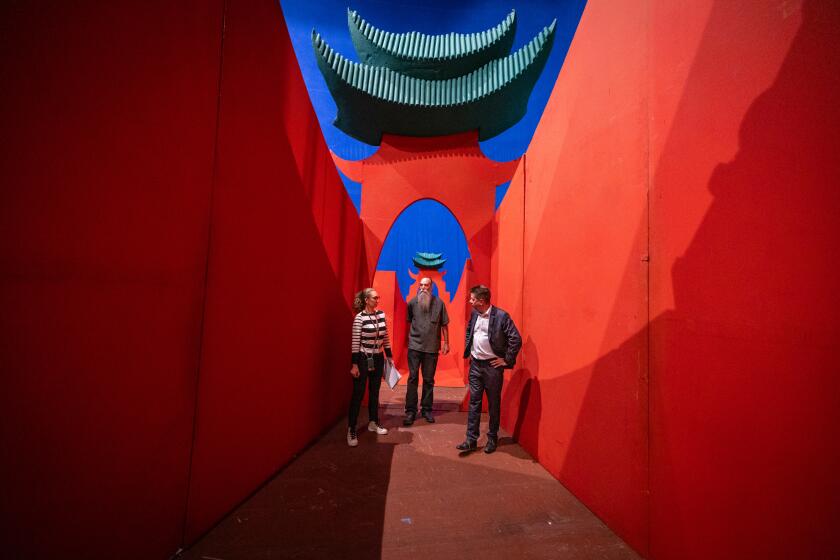His success is no mystery
Richard Hoover was in New York, designing a $32-million movie (“Rucker”) and the set of an off-Broadway musical revue (“The Thing About Men”). But at the moment, his thoughts were on his most recent project in Hollywood: a $40,000 Actors’ Gang production, “The Mysteries,” which opened Saturday.
Told that his listener would soon visit the set of “The Mysteries,” which was still being built as he spoke, Hoover had one simple request: “If you’ve got any lumber, bring it over.”
Hoover is a rarity -- a Tony-winning designer who works in L.A.’s little theaters. Not that he can always be in L.A. -- witness his presence in New York about 10 days before “The Mysteries” opened. “It’s very difficult to balance theater and film,” he said. “I’m struggling with that all the time.” He was paid $500 for his work on “The Mysteries” -- an amount, he said, that he can earn in half a day of movie work.
It’s a struggle that’s familiar to Tim Robbins, who runs the Actors’ Gang but also hired Hoover to design three of his movies: “Bob Roberts,” “Dead Man Walking” and “The Cradle Will Rock.”
Hoover “is relentless in pursuit of his vision,” Robbins said. But that vision can vary widely, depending on the medium. Movies usually call for finely detailed sets -- and ingenuity. For example, Robbins remembers how Hoover, for “The Cradle Will Rock,” made the outside of a small rehearsal hall look like a massive theater using just a marquee.
In theater, however, “I always look for people who aren’t constricted by the idea of realism,” Robbins said. “We don’t have the money to make realistic sets. It’s always better to find the essential element and then suggest things.”
Robbins and Hoover met when Hoover applied to design Robbins’ 1990 Actors’ Gang staging of “The Good Woman of Setzuan.” “I realized he knew a lot about the kind of theater I like. He had a strong sense of who Meyerhold [the Russian director and theorist known for his nonrealistic productions] was.”
No one will accuse Hoover of excessive realism in “The Mysteries.” The first half is based on four Old Testament tales as told in the medieval mystery plays (specifically the York and Wakefield cycles from England), while the second half depicts four stories from the New Testament as told by modern writers Dario Fo, Mikhail Bulgakov and Borislav Pekic. Each of the four playing areas within Hoover’s set must serve two different stories -- and these are distinctly miraculous, nonrealistic stories.
A quarter of the audience sits on pillows in the middle of the action, surrounded by four walls. Other theatergoers sit in single rows above two of the walls. The rest of the audience occupies conventional seating above a third wall.
The stories that take place in front of each wall are linked through the materials of Hoover’s set. For example, one of the areas contains a 6-inch-deep pool that serves as Noah’s flood in the first act -- the theatergoers sitting above this wall get to squirt water to help simulate the flood. Later, in the second act, the same set piece serves as a sauna in which Pilate interviews Jesus.
Director Brian Kulick said he had been frustrated by a recent attempt to do a similar environmental production. But as he discussed “The Mysteries” with Hoover, the designer kept advocating an environmental staging.
The Gang specializes in a performance style that speaks directly to an audience, without the illusion of a “fourth wall.” “Richard’s sensibility exactly mirrors the kinetic energy of the company,” Kulick said.
Hoover, who is “56, but I pretend I’m 41,” was exposed to this kind of theater at a relatively early age. Attending Knox College not far from his suburban Chicago roots, he saw a “quite disturbing and wonderful” performance by the San Francisco Mime Troupe. He also witnessed homegrown political performance art, such as a mock graveyard the student council erected to protest the Vietnam War.
Classified 4-F by the draft board because of a pituitary condition that had led to surgery when he was a boy and stopped his growth at 5 feet 2, Hoover studied design in graduate programs at Smith College and the University of Minnesota.
At the former, he designed an environmental “Animal Farm,” and he traveled to New York to see Jerzy Grotowski’s influential theater company from Poland. He arrived at Minnesota on the day of a campus tear-gas attack; his study there led to more than a year of work in the scene shop of Minnesota’s prestigious Guthrie Theater.
He moved to New York after leaving the Guthrie. While performing in an environmental “sequenced event” called “The June Combines” in the SoHo district, he recalls thinking of the other participants: “I don’t know where you people are going, but I’m going to build a little house” in the middle of the chaos -- which he did with found materials.
Lobbied for Native Americans
In the same era, he began to earn money designing shows at the GeVa Theatre in Rochester, N.Y. He credits the late director Stephen Katz, who hired him there, for emphasizing “color, boldness, high concepts.”
His introduction to film was rather unorthodox. Though he isn’t Native American and his hair was “very long and blond,” he became an activist for Indian causes in Minnesota and New York, including more than a year in which he lobbied the United Nations on behalf of enforcement of American Indian treaties. He and a friend made a documentary film about treaty rights.
A day job as a New York production assistant on the TV series “Real People” “began to burn a hole in my head” because he wasn’t designing, but the condition was rectified when he got his first film art directing job on “The Doorman” -- which led to his first L.A. job on “The Sure Thing,” Rob Reiner’s 1985 comedy.
Once in L.A., Hoover got more work in film and TV, including the influential series “Twin Peaks.” It was his “true immersion into film scenery,” he said. He had to build $500,000 worth of scenery in six weeks. “A fun riot,” he recalled.
But Hoover kept doing theater as well. “Film pays the bills. Theater pays the spirit,” he said. “The Actors’ Gang was my return to theater in the midst of a film attack.” Hoover began working regularly for the Gang. He discovered the current Gang headquarters, on Santa Monica Boulevard in Hollywood, while he was scouting locations for a film.
His work on Robbins’ prison-set movie, “Dead Man Walking,” drew him to the attention of British director Trevor Nunn, who assigned Hoover to design “Not About Nightingales,” an early Tennessee Williams play that also was set in an American prison. The project not only became Hoover’s London debut -- at the Royal National Theatre, no less -- but then played Houston’s Alley Theatre.
“It was an amazing pipe dream” to work with Nunn, Hoover said, “like joining the NBA.” When the show was first considered for New York, Hoover looked for “a weird environmental space,” but Nunn wanted to do it on Broadway. Thanks to Nunn’s insistence, Hoover became eligible for a Tony Award. He won, and accepted it from Julie Taymor.
“It’s a highly politicized event,” Hoover said of the ceremony. “I couldn’t breathe in my tuxedo, so afterward I went out and got drunk with my crew.”
“Not About Nightingales” remains Hoover’s only Broadway show. But the Tony helped him snag some important off-Broadway jobs.
Generally, however, Hoover is unconcerned about prestige, say those who know him. “For him, it’s about the project, not the venue,” Kulick said.
When Hoover talks about the future, his thoughts even turn away from design. He is part of a new company, Gossamer Films, that’s buying young adult books as potential movie properties. He’s also writing science fiction.
As a student, he was discouraged from directing when he was staging a play and one of the actresses fell asleep in midrehearsal. But now he’s thinking of directing again as well.
“Design is an ongoing struggle for survival,” he said. “Directing’s the same way, but at least it’s your own fault.
“When I stop running around, I will land in a community somewhere and just do theater. I’ll die falling off a ladder.”
More to Read
The biggest entertainment stories
Get our big stories about Hollywood, film, television, music, arts, culture and more right in your inbox as soon as they publish.
You may occasionally receive promotional content from the Los Angeles Times.






